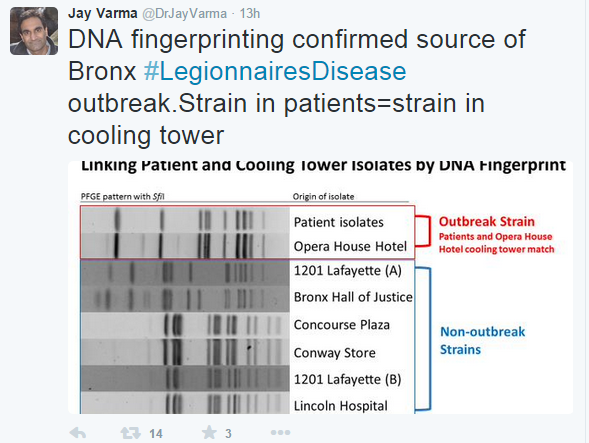The New York City Health Department’s Public Health Laboratory, in close coordination with the State’s Wadsworth Center Laboratory and the CDC, today announced that they had identified the source of the Legionnaires’ Disease outbreak in the South Bronx and declared the outbreak over. After extensive sampling of cooling towers and testing of Legionella bacteria, the laboratories have matched the Legionella strain found in the Opera House Hotel cooling tower with the strain found in patients. Epidemiologic and environmental investigations by the Health Department further support the conclusion that this cooling tower was the source of the outbreak.
The Health Department continues to investigate the circumstances that led this cooling tower to become the outbreak source; inadequate maintenance and inadequate levels of biocide may have contributed. The hotel has cooperated fully with all agencies involved in the investigation, has cleaned and disinfected its tower, and is working with the Health Department on long-term maintenance that is consistent with industry standards. Commissioner Dr. Mary T. Bassett was joined at the city’s Public Health Laboratory by Dr. Jay Varma, Deputy Commissioner for Disease Control and the Incident Commander for this outbreak, and Dr. Jennifer Rakeman, Assistant Commissioner and Director of the City’s Public Health Lab.
 “After extensive review and coordination of laboratory data at the city, state, and federal levels, we have identified the source of the outbreak in the South Bronx – the Opera House Hotel’s cooling tower,” said city Health Commissioner Bassett. “We eliminated the danger posed by the Opera House Hotel’s cooling tower as soon as it tested positive for disease-causing Legionella . Today, all cooling towers in the affected area have been disinfected, and all cooling towers across the City are being evaluated and disinfected if necessary. Historic legislation passed by the City Council and signed by Mayor de Blasio should help prevent tragic outbreaks like this from occurring again.”
“After extensive review and coordination of laboratory data at the city, state, and federal levels, we have identified the source of the outbreak in the South Bronx – the Opera House Hotel’s cooling tower,” said city Health Commissioner Bassett. “We eliminated the danger posed by the Opera House Hotel’s cooling tower as soon as it tested positive for disease-causing Legionella . Today, all cooling towers in the affected area have been disinfected, and all cooling towers across the City are being evaluated and disinfected if necessary. Historic legislation passed by the City Council and signed by Mayor de Blasio should help prevent tragic outbreaks like this from occurring again.”
“Control of Legionella is complex, and disease detection, environmental science, and laboratory advance work helped bring this unfortunate outbreak to an end. We hope to advance the science about how to improve control from New York’s experience,” said Dr. Anne Schuchat, assistant surgeon general and director of CDC’s National Center for Immunization and Respiratory Diseases. “The quick and thorough reaction from local and state authorities likely prevented many others from developing Legionnaires’ disease. CDC is appreciative of our collaborative work with New York’s public health experts.”
To determine the source of the outbreak, the laboratories used three methods – pulsed field gel electrophoresis (PFGE), sequenced based typing (SBT), and whole genome sequencing (WGS) – to determine the “DNA fingerprint” of the Legionella strain. The Health Department began by sampling water from cooling towers located in the South Bronx area where the outbreak was concentrated. The Health Department collected samples from patients. Patients are often diagnosed with Legionnaires’ Disease by tests that do not yield bacteria for further testing. The Health Department collected isolates from patients, and all of them tested positive for the strain found in the Opera House Hotel’s cooling tower.
“The city’s Public Health Laboratory worked closely with the State’s Wadsworth Center Laboratory and the Centers for Disease Control and Prevention to collect and process the samples from patients and cooling towers,” said Assistant Commissioner Rakeman. “Legionella is notoriously difficult to grow on culture, which is why identifying a particular strain can sometimes take weeks. We brought together the best of the three laboratories and used multiple methods to determine the DNA fingerprints of cooling tower water and patient isolates, which enabled us to identify this strain and link patient isolates to the cooling tower isolates quickly.”
Because the patients identified in the cluster of Legionnaires’ Disease were infected with a specific type ofLegionella — Legionella pneumophila serogroup 1 (Lp1) — the focus of all testing was on Lp1.
To test cooling towers, New York State’s Wadsworth Center used a rapid PCR test to determine if Lp1 may be present in the water by testing for the DNA of the organism. This provided a clue as to which cooling towers might be involved in the outbreak. The water samples also were cultured to grow Legionella bacteria. Some of the water samples that had an initial test showing the presence of Lp1 DNA grew Lp1 on culture. From these cultures, Lp1 isolates were “DNA fingerprinted,” and the fingerprints were compared to fingerprints of the patient isolates. The Legionella bacteria that were cultured from the Opera House Hotel cooling tower in the South Bronx had the same “DNA fingerprint” as the Legionella bacteria cultured from multiple patients.
124 Legionella cases were reported, including 12 deaths in the outbreak.


6 thoughts on “NYC Legionnaires’ outbreak declared over; Opera House Hotel ID’d as source”